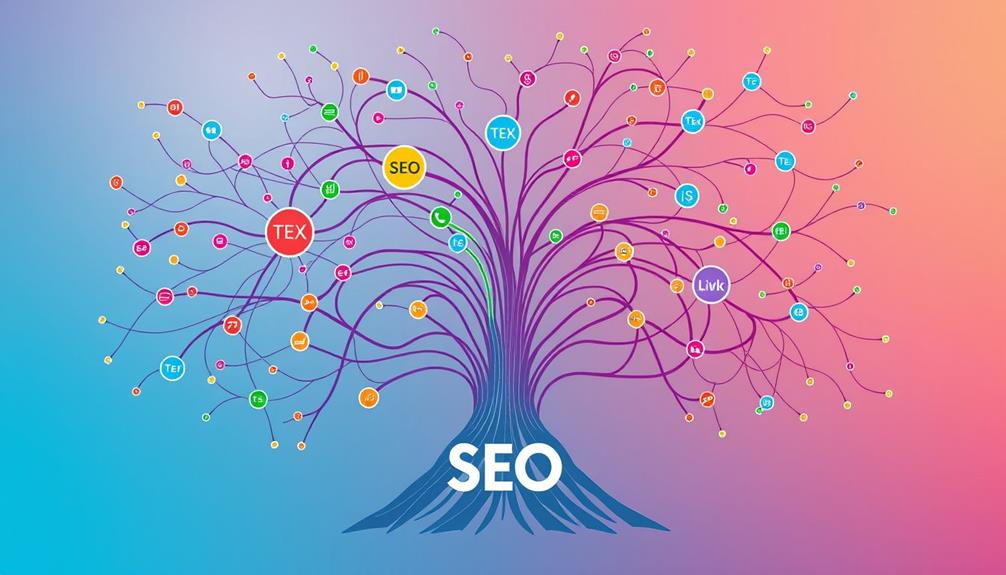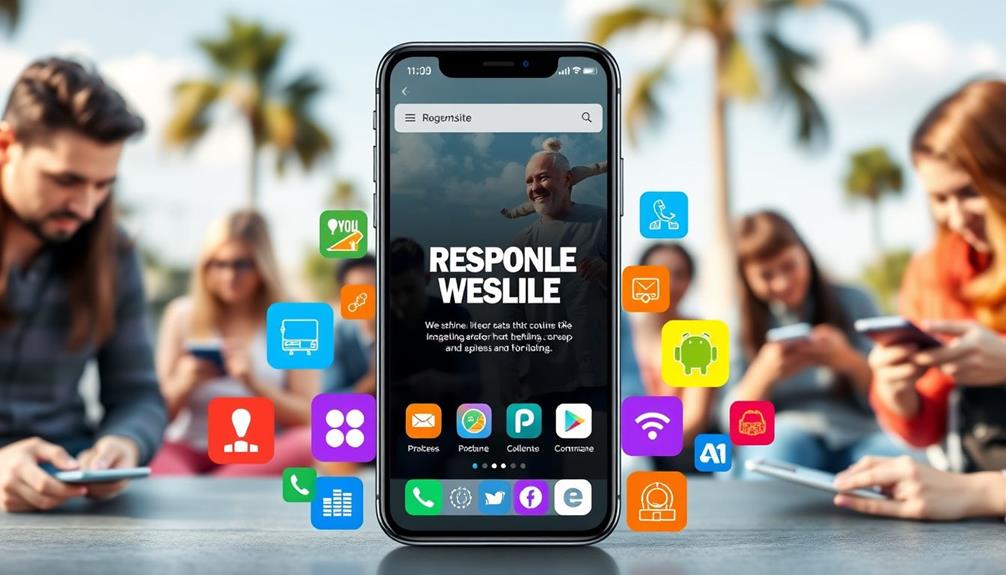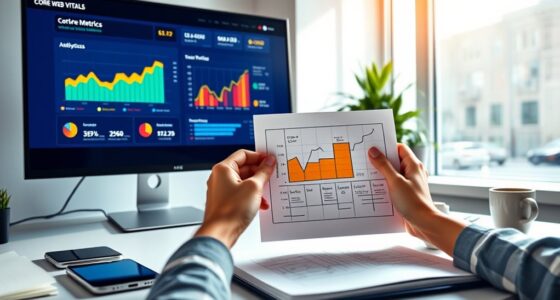Mastering internal linking is essential for strengthening your site's SEO foundation. It connects your pages, making navigation easier for both users and search engines. You'll improve user experience by guiding visitors to related content, which can reduce bounce rates and increase engagement. By strategically placing links, you also distribute link equity, boosting the visibility of lower-ranking pages. Regular audits keep your links in good shape, helping to maintain a clear site structure. This strategy ultimately leads to better search rankings and enhanced performance. Keep exploring to uncover more effective internal linking techniques that can elevate your SEO game.
Key Takeaways
- Internal links enhance user navigation, improving engagement and reducing bounce rates by guiding visitors to relevant content across the site.
- Effective internal linking strengthens site structure, aiding search engines in indexing important pages and improving crawl efficiency.
- Distributing link equity through strategic internal linking can elevate the rankings of lower-traffic pages and boost overall SEO performance.
- Regular internal link audits help identify broken links and orphan pages, ensuring a seamless user experience and maintaining site health.
- Utilizing tools like Screaming Frog and Google Search Console aids in analyzing link structures and optimizing internal linking strategies for better SEO outcomes.
What Are Internal Links?
Internal links are essential tools for connecting pages within your website, making navigation smoother for users and search engines alike. These hyperlinks link to other pages on your domain, enhancing site navigation and boosting user engagement.
In the domain of SEO, internal links play a critical role. They help search engines understand your site structure, facilitating Google's indexing process and revealing how your content relates to each other. Additionally, utilizing tools such as email marketing software selection can enhance your overall website strategy by ensuring your content remains relevant and engaging.
By strategically placing internal links, you can pass link equity from high-authority pages to those that need a ranking boost. This not only helps improve search rankings but also encourages users to explore more of your content.
Contextual links, which are embedded within the text, guide users to relevant articles, while navigation links in menus and breadcrumb links assist them in tracking their location on your site.
Utilizing internal links effectively can greatly reduce bounce rates, as visitors are more likely to stay engaged when they find related information easily.
Benefits of Internal Linking

Internal linking can greatly enhance user navigation on your site, making it easier for visitors to find related content.
By implementing keyword clustering and topic clustering, you can improve content discoverability, further boosting your search rankings and reducing bounce rates. This keeps users engaged longer.
Enhancing User Navigation
Effective navigation is essential for keeping visitors engaged on your site, and internal linking plays an important role in achieving this. By implementing a solid internal linking strategy, you can enhance user navigation by creating clear pathways to related content. This approach not only improves user experience but also encourages deeper exploration, which can greatly reduce bounce rates.
When you integrate contextual links within your content using descriptive anchor text, users are more likely to click through, leading to longer average session durations. This seamless browsing experience allows visitors to track their journey across your site, ultimately enhancing their satisfaction.
Here's a quick overview of the benefits of internal linking:
| Benefit | Description | Impact on SEO |
|---|---|---|
| Enhance User Navigation | Clear pathways to related content | Improves site architecture |
| Reduce Bounce Rate | Keeps visitors engaged longer | Signals to search engine crawlers |
| Improve User Experience | Seamless browsing experience | Positive effect on overall SEO |
| Increase Session Duration | Encourages deeper exploration | Boosts engagement metrics |
| Visibility in Search Results | Increases search impressions by 53% | Enhances discoverability |
Boosting Search Rankings
A well-planned internal linking strategy can greatly boost your search rankings by enhancing your site's structure. When you create links between your pages, search engines can crawl and index them more efficiently, leading to better visibility in search results.
By strategically linking high-authority pages to lesser-known content, you distribute link equity, which can elevate the rankings of those lower-traffic pages by up to 53%. Additionally, as the demand for AI cybersecurity jobs increases, ensuring your site is secure can also positively impact your SEO efforts.
Moreover, a well-structured internal linking strategy reduces click depth for important pages, making it easier for search engines to access and prioritize them during indexing. This means that your valuable content gets the attention it deserves.
Contextual internal links can also increase user engagement, resulting in longer session durations—both essential factors that positively influence search engine algorithms.
Regular audits of your internal links help you identify optimization opportunities, ensuring every page contributes to your overall SEO performance.
Reducing Bounce Rates
How can you keep visitors engaged and prevent them from leaving your site too quickly? The answer lies in effective internal linking. By creating clear pathways for users to navigate through related content, you can greatly reduce bounce rates. In fact, websites that implement strong internal linking strategies can see a drop in bounce rates by as much as 30%.
When you use contextual internal links within high-quality content, you guide users to related topics that pique their interest, helping to increase average session duration. This not only boosts user engagement but also improves your site's SEO performance by signaling value to search engines.
Here's a quick look at the benefits of internal linking:
| Benefit | Impact on Users | Effect on SEO |
|---|---|---|
| Reduces Bounce Rates | Keeps users on your site longer | Improves rankings |
| Increases Engagement | Encourages exploration of content | Signals value to search engines |
| Enhances Navigation | Simplifies access to related topics | Optimizes website structure |
| Boosts Average Session Duration | Users interact with multiple pages | Strengthens overall SEO performance |
Enhancing User Experience

When users can easily navigate through related topics on your site, their overall engagement skyrockets. By implementing an effective internal linking structure, you enhance user experience markedly.
This not only helps guide users to relevant content but also encourages them to explore more pages, ultimately reducing bounce rates. For instance, a well-organized site can lead pet owners to discover products like the self-cleaning brush roll which effectively tackles pet hair issues.
Here's how you can improve user experience with internal links:
- Seamless Navigation: Confirm links connect related topics, making it simple for users to find what they're looking for.
- Content Relevance: Use internal links to direct users to content that complements their interests, enhancing engagement.
- Regular Audits: Regularly check for broken links to maintain a smooth navigation experience and prevent user frustration.
Driving Conversions Through Linking

Internal linking not only enhances user experience but also plays a pivotal role in driving conversions. By implementing strategic internal links, you can guide users through their buyer's journey, presenting relevant content at every stage of their decision-making process. This approach increases the likelihood of a conversion rate increase of up to 50%, as users engage more with interconnected content that resonates with their needs.
For instance, understanding key factors in choosing a home cleaning service can help users make informed decisions about the services they require.
Linking to high-converting landing pages from blog posts or related content directs traffic effectively, opening doors for higher lead generation and sales opportunities. Furthermore, a well-planned internal linking strategy can notably enhance user engagement metrics, including average session duration and pages per session. These metrics are critical indicators of user interest and can lead to more conversions.
Additionally, strong internal linking can reduce bounce rates by up to 30%, ensuring users explore more pages on your site. This exploration increases the chances of them completing desired actions, like signing up or making a purchase.
Building Site Architecture

Building a solid site architecture is essential for enhancing your wayfinding structure and organizing your content hierarchy.
When users can easily find related content, they're more likely to stay on your site, reducing bounce rates. Implementing a clear structure can also reflect the value of home security systems, as users feel a sense of safety and assurance while exploring your site.
Plus, a clear architecture improves crawl efficiency, helping search engines index your pages more effectively.
Enhancing Navigation Structure
A well-organized navigation structure is essential for enhancing your website's architecture. By implementing effective internal links, you create a clear path for both users and search engines to follow, considerably improving the user experience.
When your site's layout is intuitive, users can easily find relevant content, leading to lower bounce rates and increased session duration. Additionally, fostering a culture of creativity and experimentation through design thinking can inspire innovative approaches to your site's structure, enhancing overall functionality and user engagement design thinking leadership.
Here are some key benefits of a solid navigation structure:
- Efficient Link Distribution: A logical hierarchy allows for better link equity distribution, boosting the authority of less popular pages.
- Improved Crawlability: Search engines can more easily crawl and index your site when content is well-organized, resulting in better rankings.
- Regular Internal Link Audits: Conducting audits helps identify orphan pages, ensuring all important content is accessible and interconnected.
Organizing Content Hierarchy
When you organize your content hierarchy effectively, you create a framework that guides both users and search engines through your website. A clear content structure not only enhances site navigation but also guarantees users can easily find significant pages.
For instance, incorporating sections on unique indoor planters or self-watering planters can further enrich user experience. By implementing categories and tags, you can improve the visibility of related content, making navigation intuitive.
Your internal linking strategy should prioritize these key pages, allowing high-authority content to pass value to lesser-known ones. This approach boosts their SEO performance and strengthens the overall site architecture.
Breadcrumb navigation is another powerful tool in organizing content hierarchy, as it enables users to track their path and return to previous sections, greatly enhancing user experience.
Regular audits of your internal linking structure are vital too; they help uncover content gaps and identify orphan pages that may be missing connections. By addressing these issues, you guarantee all vital information is accessible for both users and search engines.
Fundamentally, organizing your content hierarchy lays a solid foundation for effective internal links, ultimately leading to a more engaging and SEO-friendly website.
Improving Crawl Efficiency
Organizing your content hierarchy lays the groundwork for improving crawl efficiency. When you use internal links wisely, you create a clear site architecture that helps search engines navigate your site more easily.
This means they can index your content without stumbling upon orphan pages, enhancing your overall search visibility. In today's digital landscape, where hackathon trends are reshaping tech skills, effective internal linking becomes essential for showcasing your site's most valuable content.
To boost crawl efficiency, focus on these strategies:
- Develop an internal linking strategy: Link to important pages throughout your site to reduce click depth and make them easily accessible.
- Utilize categories and tags: This helps in content organization, allowing search engines to understand relationships between pages better.
- Keep your XML sitemap updated: Regular updates, combined with strategic internal linking, help crawlers prioritize indexing content that matters most.
Improving Crawl Efficiency

Improving crawl efficiency is essential for getting your content noticed by search engines. By implementing effective internal links, you enhance the way crawlers discover and index your pages. This reduces the click depth to important content, ultimately boosting your site visibility. A well-structured linking practice increases the crawl frequency of your high-priority pages, ensuring they get recognized and ranked more quickly.
For example, protecting your savings through strategic investments can also apply to enhancing your site's structure.
When you connect pages within your site using interconnected content, search engines prioritize these links, crawling them more frequently than isolated pages. This practice prevents orphan pages from slipping through the cracks.
Additionally, using a clear hierarchy in your internal links helps search engines understand your site structure, making it easier for them to navigate and index your content logically, which can contribute to improved rankings.
Regular audits of your internal links are vital. They can help identify broken links and redirect chains, optimizing crawl efficiency. By ensuring all linked content is accessible, you not only enhance your site's SEO but also improve user experience.
Best Practices for Internal Linking

Effective internal linking is a key component of a well-optimized website. By strategically placing internal links, you can enhance your SEO strategy and improve user experience. Here are some best practices to keep in mind:
- Aim for 5-10 internal links per 2,000 words of content. This helps maintain effective navigation without overwhelming users or diluting link equity.
- Use descriptive anchor text that's rich in keywords. This enhances clarity and relevance, guiding both users and search engines to your high-quality content.
- Conduct regular site audits every four to six weeks with tools like Screaming Frog. This guarantees you fix broken links, maintaining a seamless user experience.
Remember to prioritize linking to cornerstone content to effectively distribute link equity and boost the rankings of less popular pages.
Additionally, limit the number of internal links on a single page to fewer than 100 to avoid clutter.
Tools for Internal Link Analysis

When it comes to optimizing your internal linking strategy, using the right tools can make all the difference. Tools like Screaming Frog and Google Search Console are essential for conducting thorough internal link analysis. They help you identify broken links and pinpoint areas for optimization that can greatly enhance your SEO performance.
Additionally, SEO analysis tools such as Ahrefs and SEMrush provide valuable insights into internal link distribution, allowing you to understand the flow of link equity across your site. By tracking user engagement metrics, these tools reveal which links are most clicked, guiding your future internal link placement and content strategy.
Automated internal linking tools, like seoClarity's Link Optimizer, can streamline the creation of internal links. This guarantees consistency and efficiency, especially on larger websites.
Regular use of these internal link analysis tools helps maintain a healthy link structure, preventing orphan pages and ensuring that all critical content is easily accessible to both users and search engines. By leveraging these tools effectively, you can enhance your internal linking strategy and boost your site's overall performance.
Conclusion
In the digital age, mastering internal linking is like having a well-structured roadmap for your site. By enhancing user experience and improving crawl efficiency, you're not just boosting SEO; you're guiding visitors where they need to go. Remember, a site without solid internal links is like a ship without a compass—lost and directionless. So, embrace these strategies, keep your links relevant, and watch your site thrive in the vast online ocean.










